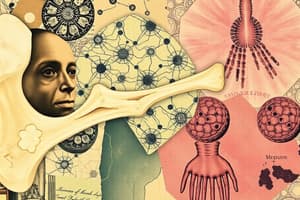Podcast
Questions and Answers
What is an Osteon?
What is an Osteon?
Long cylindrical unit that runs lengthwise through compact bone.
What are Osteocytes?
What are Osteocytes?
Mature bone cells, found in a lucana.
What are Osteoblasts?
What are Osteoblasts?
Bone forming cells, first bone cells to appear.
What are Osteoclasts?
What are Osteoclasts?
What are Lamellae?
What are Lamellae?
What are Haversian Canals?
What are Haversian Canals?
What are Canaliculi?
What are Canaliculi?
What are Volkmann's canals?
What are Volkmann's canals?
What are projections and processes in bone terminology?
What are projections and processes in bone terminology?
What are depressions and cavities in bone terminology?
What are depressions and cavities in bone terminology?
What is a Tuberosity?
What is a Tuberosity?
What is a Crest?
What is a Crest?
What is a Trochanter?
What is a Trochanter?
What is a Tubercle?
What is a Tubercle?
What is a Spine in bone terminology?
What is a Spine in bone terminology?
What is a Process in bone terminology?
What is a Process in bone terminology?
What is a Facet?
What is a Facet?
What is a Condyle?
What is a Condyle?
What are the Functions of the skeleton?
What are the Functions of the skeleton?
What is hematopoiesis?
What is hematopoiesis?
What are the Types of bone?
What are the Types of bone?
What are the classifications of bone?
What are the classifications of bone?
What is the diaphysis?
What is the diaphysis?
What is the periosteum?
What is the periosteum?
What is the epiphysis?
What is the epiphysis?
What is articular cartilage?
What is articular cartilage?
What is the epiphyseal line?
What is the epiphyseal line?
What are Sharpey's fibers?
What are Sharpey's fibers?
What is compact bone?
What is compact bone?
What is spongy bone?
What is spongy bone?
What is red marrow?
What is red marrow?
What is the medullary cavity?
What is the medullary cavity?
What is yellow marrow?
What is yellow marrow?
What is the endosteum?
What is the endosteum?
Flashcards are hidden until you start studying
Study Notes
Bone Structure and Cells
- Osteon: Long cylindrical units that run lengthwise through compact bone, essential for bone strength and structure.
- Osteocytes: Mature bone cells located in lacunae, involved in maintaining bone tissue.
- Osteoblasts: Bone-forming cells responsible for the creation of new bone tissue, known as bone makers.
- Osteoclasts: Bone-resorbing cells that break down bone tissue, often referred to as bone breakers.
Bone Composition
- Lamellae: Concentric rings of minerals and collagen that form the structure of compact bone.
- Haversian Canals: Central holes in osteons that house blood vessels and nerves, crucial for supplying nutrients.
- Canaliculi: Tiny canals that connect osteocytes, facilitating communication and transport of nutrients and oxygen.
- Volkmann’s Canals: Canals that run perpendicular to Haversian canals, aiding in the connectivity of the bone's vascular network.
Bone Projections and Deficiencies
- Projections and Processes: Features that extend outward from bones, typically described by terms starting with 't'.
- Depressions and Cavities: Indentations in bone structure, often categorized with terms starting with 'f' (excluding facets).
- Tuberosity: A large rounded projection, often serving as a muscle attachment site.
- Crest: A narrow, prominent ridge on a bone.
- Trochanter: A large, blunt, irregularly shaped projection found on the femur.
- Tubercle: A small, rounded projection or process on a bone.
- Spine: A sharp, slender, pointed projection of bone.
- Process: General term for any bony prominence.
- Facet: A smooth, nearly flat surface for articulation.
- Condyle: Rounded articular projection that forms a joint.
Functions and Types of Bone
- Functions of the Skeleton: Protects vital organs, supports body structure, stores minerals, provides muscle attachment points, and facilitates hematopoiesis (blood cell production).
- Hematopoiesis: The process occurring within bones to produce blood cells.
- Types of Bone: Classified into compact bone and spongy bone based on density and structure.
- Classification of Bone: Long, short, flat, and irregular bones, each with specific shapes and functions.
Bone Anatomy
- Diaphysis: The shaft or central part of a long bone, primarily composed of compact bone.
- Periosteum: A fibrous connective tissue covering the outer surface of bones, important for protection and growth.
- Epiphysis: The ends of long bones, often involved in joint formation with articular cartilage.
- Articular Cartilage: Hyaline cartilage covering bone ends at joints, reducing friction and absorbing shock.
- Epiphyseal Line: The growth plate found in long bones, indicating where growth occurs.
- Sharpey's Fibers: Microscopic fibers that anchor the periosteum firmly to the bone surface.
Bone Marrow and Cavity
- Compact Bone: Dense bone that forms the diaphysis, where minerals are abundant.
- Spongy Bone: Found in the epiphysis, characterized by a porous structure that contains red marrow.
- Red Marrow: Located within spongy bone, responsible for red blood cell production.
- Medullary Cavity: Central cavity in the diaphysis filled with yellow marrow, used for fat storage.
- Yellow Marrow: Adipose tissue stored in the medullary cavity.
- Endosteum: A thin layer of cells that lines the medullary cavity, involved in bone growth and repair.
Studying That Suits You
Use AI to generate personalized quizzes and flashcards to suit your learning preferences.




